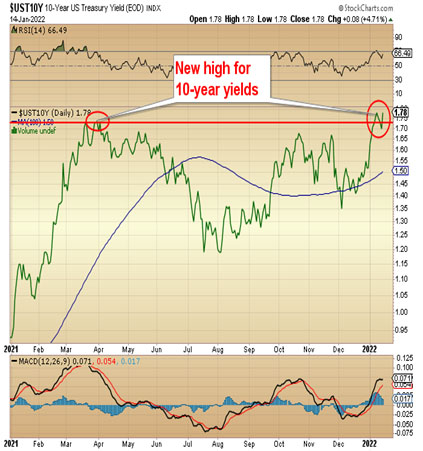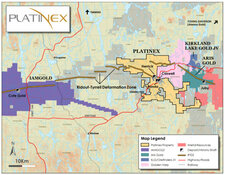Being my first weekly missive of 2022, I want to touch upon an Email Alert I sent out to subscribers on New Year’s Day where I discussed the “First Five Days” segment of “The January Barometer,” an indicator developed by the late Yale Hirsch (with whom I had dinner back in 1996) who founded The Stock Trader’s Almanac, a booklet I have ordered every year since meeting Mr. Hirsch in Connecticut while on an eastern U.S. road trip with a Canadian diamond explorer. The January Barometer has a 73.2% batting average in that every down January on the S&P since 1950 has, without exception, preceded a new or extended bear market, a flat market, or a 10% correction.
When the “First Five Days” of January result in a net gain for the year, markets have had an 82.6% probability of posting an up year and while this indicator is not as reliable in predicting bear markets, I find it very interesting that the last time the market saw a new high in December followed by a negative “First Five Days” was 1981, shortly after Fed Chairman Paul Volcker declared war on inflation and which kicked off the 1981–1982 bear market that ended when the Fed did an abrupt U-turn and started slashing borrowing costs after throwing the world into recession and unemployment through the roof.
The iconic Richard Russell used both the first five days and the January barometer as tools but he also added a third signal and that was the mid-month scorecard so if we take all three and apply them to the Dow Jones Industrials, the S&P 500, the NASDAQ 100, and the TSX 300, the results come out as follows:
Index First Five Days Mid-month
DJIA -0.29% -1.17%
S&P 500 -1.87% -2.17%
NDX 100 - 4.46% -4.30%
TSX 300 -0.65% +0.65%
While the jury is out on the remainder of January, the first segment of the barometer has turned negative and Richard Russell’s mid-month signal is now negative so the odds would favor a down month. I find it interesting that the Canadian market (TSX 300) eked out a modest gain for the first two weeks but also failed the first five days signal. To add more fuel to the fire, we now have a hostile Fed being barked at by the White House to “do something” about inflation because those nasty mid-term elections are not going to treat the Democrats very nicely with a 7% CPI.
Every time I see Jerome Powell on the monitor, I am immediately reminded of Marty Zweig’s immortal words, “Don’t fight the Fed and don’t fight the tape.” What I learned at the Wharton School back in the mid-80s was that the mistake people make all the time is trying to second-guess the Fed. How many times have we heard the breathless utterances “The Fed is TRAPPED!” as an excuse for staying fully invested. This week alone I counted no fewer than five gurus all singing from the old bull market hymn sheet, absolutely adamant that the Fed would do nothing to derail the stock and housing markets but what they fail to grasp is that for the past three months, Mr. Powell has been threatening to take away the stimulus and in fact initiate “quantitative tightening,” an event that has been more than adequately telegraphed to the member banks, affiliated brokerage houses and, most importantly, to the thousands of fund and ETF managers that are vulnerable to rising interest rates. In hockey, you only telegraphed a pass to a teammate that refused to pick up a bar tab because it gave the 7-foot goon on defense a chance to line him up; in the world of bonds and stocks, the Fed will always telegraph its hostile intentions in order to avoid a “disorderly decline in markets.” In other words, it cares not about the public trading Apple or Tesla or ARRK funds; it only cares about its members and that they are adequately flat or hedged by the time the boom is lowered.
 The 10-year yield has just broken out to new highs and is on its way above the 2% threshold that many have considered “terminal” in terms of “accident-creating” but as I have been chortling about for what seems like an eternity, accidents will force the Fed to blink only if they affect the banking system and if the banks are all hedged, then it is a “No harm, no foul” scenario. I know I must sound like a nagging fishwife with a migraine headache trying to quit smoking but investors have to understand that this insidious inflation that has the Democrats so thoroughly terrorized can only be fought with policy moves that are injurious to everything that is not nailed down (except uranium and possibly copper). Any investor that thinks the Fed can combat the rising CPI with selective targeting of individual goods and services is dreaming. The only tool the Fed can used is not a rifle with a telescopic sight; it is a double-barreled shotgun that will mow down everything in its path, including tech stocks and crypto.
The 10-year yield has just broken out to new highs and is on its way above the 2% threshold that many have considered “terminal” in terms of “accident-creating” but as I have been chortling about for what seems like an eternity, accidents will force the Fed to blink only if they affect the banking system and if the banks are all hedged, then it is a “No harm, no foul” scenario. I know I must sound like a nagging fishwife with a migraine headache trying to quit smoking but investors have to understand that this insidious inflation that has the Democrats so thoroughly terrorized can only be fought with policy moves that are injurious to everything that is not nailed down (except uranium and possibly copper). Any investor that thinks the Fed can combat the rising CPI with selective targeting of individual goods and services is dreaming. The only tool the Fed can used is not a rifle with a telescopic sight; it is a double-barreled shotgun that will mow down everything in its path, including tech stocks and crypto.
As Richard Russell used to write, “In a bear market, it is the person that loses the least amount of money that wins the race.” Since we have not had anything even approaching a bear market since the 2008 Great Financial Bailout – (the COVID CRASH was a brief hiccup with a “friendly Fed” saving the world) – the vast majority of investors have become conditioned to markets that only go in one direction. “Buy the dip” worked in in 1987, 2001, 2008, and 2020 because not once during that forty-odd-year bull market did investors ever run into a Volcker-esque disciplinarian with inflation in his crosshairs. Now, Jerome Powell is no Paul Volcker but with the sanction and blessing of the White House, my bet is that he does a pretty good impression.
As for precious metals, they failed the first five days and the mid-month tests but then again, I have no idea whether they adhere to the January barometer. I remain positive on both gold and silver but with a cautionary note. During the 1981–1982 bear market, gold fell from USD $555 to $437 for a 21.3% drop, so only a massive secular shift in asset allocation models can offset the anti-inflationary policy moves by the Fed. Such a shift can only occur if there is a prolonged decline in the U.S. dollar, which can only occur if rates rise more rapidly and with greater elasticity than in the U.S. I am a lonely voice in the wilderness when I say that with the U.S. debt level at such a staggering height, the likelihood of rising interest expense deterring foreign investment in the U.S. dollar is high (and rising).
Dovetailing back to the Richard Russell comment on “bear market winners losing least,” the gold and silver miners remain the cheapest sector in the entire market to own with oil and gas producers a close second. Every ESG-sensitive fund on the planet has thrown out oil & gas babies with bathwater as they scramble for “WOKE” acceptance and politically acceptable images resulting in structural weakness unaccompanied by operational impairment – and that always spells opportunity.
The truth is that since valuation for the metals and oils is so low, their risk levels are also low, so while they may not be able to go higher in a secular bear market scenario, they will undoubtedly outperform virtually everything else (including housing). Within the gold mining sector, the senior producers are cheap, the mid-tier producers are cheap and the junior developers are beyond cheap. They are absurdly undervalued. By example, take Getchell Gold Corp.'s (GTCH:CSE; GGLDF:OTCQB) announcement of an 8.2-meter interval of 8.8 grams per tonne gold at its Fondaway Canyon Project in Nevada. Despite spectacular results in a highly favorable jurisdiction with money in its treasury, investors just yawned. You have to go back to January 2016 or March 2020 to recall these levels of investor apathy. To wit, back in the 1990s, if any junior reported 27’ of quarter-ounce-plus gold, the stock would be halted for a couple of days and open up over a double.
I am constantly asked what has to occur in order to create interest in the exploration juniors. Why does a Great Bear Resources (GBR:TSXV) advance from the pennies to over CA$29/share solely on reported drill holes, without a resource estimate, and get taken over while others have the same high-grade results in a favorable location and are unable to buy a bid? The answer is found between the walls of the boardroom; Great Bear has several directors that know the drill on how to attract prospective financiers, investors, and ultimately, suitors.
Nowhere is the term “experienced management” more important than in the world of junior mining. Nowhere in the world of public markets do you fund such a bifurcation of managerial diversity; it seems that you find yourself with either high-integrity operators and lousy projects or amateur hour managers trying to advance decent projects. There does not appear to be any middle ground but when drill hole data is brought to the market by executives schooled in the art of advancing the value of their companies, the market pays heed. Management can be composed of superb technical personnel and come with really good results, but if they are weak in the capital markets battlefield, investors will suffer.
Warren Buffett likes to use the analogy of “you have to wait for the tide to go out before you see who has no swimsuit on” as a means of describing the true talent of a fund manager. It is no different for the junior miners. In the six months after the COVID crash and gold broke out to all-time highs above USD $2,000/ounce, the junior gold and silver space became supersaturated with ex-hockey-players, used car salesmen, carnival barkers, and snake oil purveyors of all sizes and temperaments wandering in and out of the brokerage firm zoom terminals with fistfuls of cash and oversubscribed financings of obscene proportions; that was the tide going in.
We are now in the eighteenth month of the corrective phase in the junior gold and silver mining space. We now know who has no swimming trunks on because the financing tide went out over a year ago. Now that all the easy funding has dried up, we are going to see who has the mettle to survive and just who has the boardroom finesse and project power to create value for shareholders. Since success is no longer measured by the width and grade of a drill intercept, innovative methods of attracting the investor dollar and attention span are going to be needed.
There are times when markets render us into the “Jim Phelps mode,” that memorable character played by Peter Graves in the legendary 1960’s action serial Mission: Impossible. I find it empowering that despite the title, the missions were always completed perfectly.
“Your mission, Mr. Phelps, should you choose to accept it, is to locate those junior mining companies that have sub-par management but above-average projects that can actually go up in price. This message will self-destruct in ten seconds.”
Originally published on Jan. 15, 2022.
Follow Michael Ballanger on Twitter @MiningJunkie. He is the Editor and Publisher of The GGM Advisory Service and can be contacted at miningjunkie216@outlook.com for subscription information.
Originally trained during the inflationary 1970s, Michael Ballanger is a graduate of Saint Louis University where he earned a Bachelor of Science in finance and a Bachelor of Art in marketing before completing post-graduate work at the Wharton School of Finance. With more than 30 years of experience as a junior mining and exploration specialist, as well as a solid background in corporate finance, Ballanger's adherence to the concept of "Hard Assets" allows him to focus the practice on selecting opportunities in the global resource sector with emphasis on the precious metals exploration and development sector. Ballanger takes great pleasure in visiting mineral properties around the globe in the never-ending hunt for early-stage opportunities.
Disclosure:
1) Michael J. Ballanger: I, or members of my immediate household or family, own securities of the following companies mentioned in this article: Getchell Gold Corp. My company has a financial relationship with the following companies referred to in this article: Getchell Gold Corp. I determined which companies would be included in this article based on my research and understanding of the sector. Additional disclosures are below.
2) The following companies mentioned in this article are billboard sponsors of Streetwise Reports: None. Click here for important disclosures about sponsor fees. The information provided above is for informational purposes only and is not a recommendation to buy or sell any security.
3) Statements and opinions expressed are the opinions of the author and not of Streetwise Reports or its officers. The author is wholly responsible for the validity of the statements. The author was not paid by Streetwise Reports for this article. Streetwise Reports was not paid by the author to publish or syndicate this article. Streetwise Reports requires contributing authors to disclose any shareholdings in, or economic relationships with, companies that they write about. Streetwise Reports relies upon the authors to accurately provide this information and Streetwise Reports has no means of verifying its accuracy.
4) This article does not constitute investment advice. Each reader is encouraged to consult with his or her individual financial professional and any action a reader takes as a result of information presented here is his or her own responsibility. By opening this page, each reader accepts and agrees to Streetwise Reports' terms of use and full legal disclaimer. This article is not a solicitation for investment. Streetwise Reports does not render general or specific investment advice and the information on Streetwise Reports should not be considered a recommendation to buy or sell any security. Streetwise Reports does not endorse or recommend the business, products, services or securities of any company mentioned on Streetwise Reports.
5) From time to time, Streetwise Reports LLC and its directors, officers, employees or members of their families, as well as persons interviewed for articles and interviews on the site, may have a long or short position in securities mentioned. Directors, officers, employees or members of their immediate families are prohibited from making purchases and/or sales of those securities in the open market or otherwise from the time of the decision to publish an article until three business days after the publication of the article. The foregoing prohibition does not apply to articles that in substance only restate previously published company releases. As of the date of this article, officers and/or employees of Streetwise Reports LLC (including members of their household) own securities of Getchell Gold Corp., a company mentioned in this article.
Michael Ballanger Disclaimer:
This letter makes no guarantee or warranty on the accuracy or completeness of the data provided. Nothing contained herein is intended or shall be deemed to be investment advice, implied or otherwise. This letter represents my views and replicates trades that I am making but nothing more than that. Always consult your registered advisor to assist you with your investments. I accept no liability for any loss arising from the use of the data contained on this letter. Options and junior mining stocks contain a high level of risk that may result in the loss of part or all invested capital and therefore are suitable for experienced and professional investors and traders only. One should be familiar with the risks involved in junior mining and options trading and we recommend consulting a financial adviser if you feel you do not understand the risks involved.
All charts and graphics are provided by the author.































































